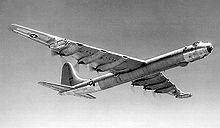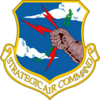|
347th Bombardment Squadron
The 347th Bombardment Squadron is an inactive United States Air Force unit. It was last assigned to the 4047th Strategic Wing, and was inactivated at McCoy Air Force Base, Florida on 1 April 1963. The squadron was first activated in 1942. After training in the United States, it moved to the Mediterranean Theater of Operations, where it earned two Distinguished Unit Citations in operations against the Axis Powers. After V-E Day, the squadron remained in Italy until November 1945, when it was inactivated. The squadron was activated in the reserves from 1947 to 1949, but does not appear to have been fully manned or equipped. In 1953, the squadron was activated as the 347th Strategic Reconnaissance Squadron as part of Strategic Air Command. It returned to the bombardment mission two years later, and served in this role until inactivating in 1963. HistoryWorld War II The squadron was activated in June 1942 as one of the four original squadrons of the 99th Bombardment Group, at Orlando Army Air Base, Florida, moving on paper the same day to MacDill Field, Florida. However, the Army Air Forces had decided to concentrate all heavy bomber training under Second Air Force, and before the end of the month, the squadron moved to Pendleton Field, Oregon to begin its training in Boeing B-17 Flying Fortresses. It continued training with the B-17 until January 1943, when it began deploying to the Mediterranean Theater of Operations.[1] The squadron's ground echelon went by ship from New York City to Marrakech, Morocco; the air echelon flew to Morrison Field, Florida, then along the South Atlantic Route.[citation needed] The ground and air echelons of the squadron were reunited at Navarin Airfield, Algeria in March 1943. It moved forward to Oudna Airfield, Tunisia after the Allies drove Axis forces from North Africa in May 1943. The squadron concentrated on targets such as airfields, harbor facilities, shipping, viaducts and bridges in North Africa, Sicily and Italy.[3] In early June 1943, the squadron participated in Operation Corkscrew, the reduction of Pantelleria Island in preparation for the invasion of Sicily.[4] The squadron helped neutralize enemy fighter aircraft opposition to Operation Husky, the invasion of Sicily, penetrating enemy air defenses by bombing airplanes, hangars and fuel and ammunition storage sites at Gerbini Airfield. For these actions, it was awarded the Distinguished Unit Citation (DUC).[3] In November 1943, the 347th became part of Fifteenth Air Force, which focused on the strategic bombing campaign against Germany. The following month it moved to Tortorella Airfield, Italy. From this base, it engaged in the bombardment of enemy targets in Austria, Bulgaria, Czechoslovakia, France, Germany, Greece, Hungary, Italy, Romania, and Yugoslavia; attacking oil refineries, marshaling yards, aircraft factories, and other strategic objectives. On 23 April 1944, the squadron participated in an attack on aircraft factories in Wiener Neustadt, Austria, despite heavy enemy interceptor opposition. For this action, it was awarded a second DUC.[3] Following V-E Day, the squadron became part of the occupation forces in Italy, until inactivating in November 1945.[1][3] Air Force reserveThe squadron was again activated under Air Defense Command (ADC) in the reserve at Birmingham Municipal Airport, Alabama, on 19 May 1947 and again assigned to the 99th Group.[1] Its training was supervised by ADC's 477th AAF Base Unit (later the 2587th Air Force Reserve Training Center).[5] Although it was nominally a very heavy bomber unit, it is not clear whether or not the squadron was fully staffed or equipped with combat aircraft.[6] In 1948 Continental Air Command (ConAC) assumed responsibility for managing reserve and Air National Guard units from ADC.[7] President Truman’s reduced 1949 defense budget, however, required reductions in the number of units in the Air Force,[8] ConAC also reorganized its reserve units under the Wing Base Organization, and the 19th Air Division and other reserve units at Birmingham Municipal Airport, including the squadron, were inactivated and replaced by the 514th Troop Carrier Wing in June 1949.[1][5] Strategic Air Command The squadron was reactivated in January 1953 at Fairchild Air Force Base, Washington when the 111th Strategic Reconnaissance Wing, an Air National Guard unit that had been mobilized for the Korean War, was returned to state control. The squadron assumed the mission, personnel, and Convair RB-36 Peacemaker strategic reconnaissance aircraft of the 111th Wing's 129th Strategic Reconnaissance Squadron, a regular unit assigned to the 111th Wing, which was simultaneously inactivated. Engaged in worldwide strategic bombardment training and stood nuclear alert until 1956 when the B-36 was retired. In 1956, it moved to Westover Air Force Base, Massachusetts, where it was equipped with Boeing B-52D Stratofortress intercontinental heavy bombers. In 1961 it moved to McCoy Air Force Base, Florida and was assigned to SAC's 4047th Strategic Wing as SAC dispersed its heavy bomber force. The squadron conducted worldwide strategic bombardment training missions and providing nuclear deterrent. It was finally inactivated in 1963 when SAC inactivated its strategic wings, replacing them with permanent Air Force Wings. The squadron was inactivated and its aircraft, personnel, and equipment transferred to the 367th Bombardment Squadron, which was simultaneously activated. Lineage
Assignments
Stations
Aircraft
Awards and campaigns
See also
ReferencesNotes
Bibliography
Information related to 347th Bombardment Squadron |
||||||||||||||||||||||||||||||||||||||||||||||||||||||||||||||||||||||||||||||||||||||||||||||||



